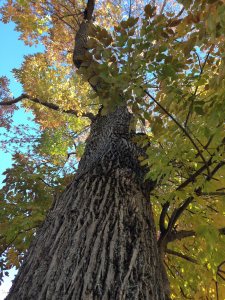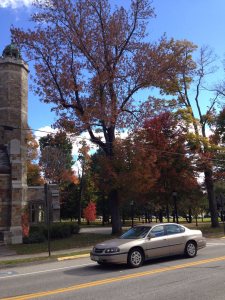White Ash
Fraxinus americana Family: Oleaceae
Submission: Bruno Zicarelli ‘17
Leaves – compound; usually with 7 more or less elliptical, entire-serrate, petioled leaflets that turn purple in fall.
Twigs – stout and glabrous.
Buds – broadly ovoid with 4-6 brownish scales; first pair of laterals are at the same level as the terminal and the leaf scar is usually notched.
Fruit – wings are generally rounded at the apex and ending at the apex of the seed cavity.
Bark – ashy gray; initially smooth with interlacing corky ridges later.
Natural History:
White ash (Fraxinus americana) is native to the entire eastern corridor of North America, extending from Nova Scotia to Florida and west to Texas (and Hawaii where it is cultivated). White Ash is a shade tolerant early successional species, growing well in well-drained moist soils. It is found at relatively low elevations in the Northeast, and slightly elevated ridges in the floodplains of major streams in the central states. Native trees can grow up to 80 feet tall, with a conical or rounded crown at maturity.
 White ash is often planted on streets to provide shade. Because of its colorful fall foliage it is used on campuses and in parks. Many cultivars have been developed to achieve different colors, but they are usually yellow, orange, or purple. The wood of white ash is valued for its durability, strength, and shock resistance. Native Americans used white ash for tool making and several medicinal purposes such as laxatives and tonic for women after childbirth. The seeds were used as an aphrodisiac, diuretic, and cure for fevers. Bark tea was used for anti-inflammatory purposes as well as curing snakebites. Today white ash is famous for its use in baseball bats (it’s shock resistant properties make it ideal for this). The wood is also used in doors, veneer, antique vehicle parts, furniture, canoe paddles, snowshoes, boats, posts, and railroad cars. White ash is considered to be the most valuable wood of the ash species.
White ash is often planted on streets to provide shade. Because of its colorful fall foliage it is used on campuses and in parks. Many cultivars have been developed to achieve different colors, but they are usually yellow, orange, or purple. The wood of white ash is valued for its durability, strength, and shock resistance. Native Americans used white ash for tool making and several medicinal purposes such as laxatives and tonic for women after childbirth. The seeds were used as an aphrodisiac, diuretic, and cure for fevers. Bark tea was used for anti-inflammatory purposes as well as curing snakebites. Today white ash is famous for its use in baseball bats (it’s shock resistant properties make it ideal for this). The wood is also used in doors, veneer, antique vehicle parts, furniture, canoe paddles, snowshoes, boats, posts, and railroad cars. White ash is considered to be the most valuable wood of the ash species.
An invasive insect known as the emerald ash borer threatens white ash. The emerald ash borer is able to kill an ash tree within 3-5 years after infestation. After the onset of infestation it is very difficult to eradicate the emerald ash borer because it burrows deep into the bark.
References:
Brockman, C.F. 1986. Trees of North America: A Guide to Field Identification. Revised Edition. Western Pub. Co., Inc. 280pp.
Elias, T.S. 1980. The Complete Trees of North America Field Guide and Natural History. Van Nostrand Reinhold Co., N.Y. 948pp.
Harlow, W.M., Harrar, E.S., Hardin, J.W. and White, F.M. 1991. Textbook of Dendrology. McGraw-Hill Inc., N.Y. 501pp.
Jensen, E, Niemara, A, Peterson, J, Seiler J. 2015. Virginia Tech Dept. of Forest Resources and Environmental Conservation; [Accessed 2015 November 4] http://dendro.cnre.vt.edu/dendrology/syllabus/factsheet.cfm?ID=46
Nesom, G. 1993. USDA, NRCS; [Accessed 2015 November 4]http://plants.usda.gov/plantguide/pdf/cs_fram2.pdf
Petrides, G.A. 1972, A Field Guide to Trees and Shrubs. 2nd edition. Houghton Mifflin Co., Boston. 428pp.
Preston, R.J., Jr. 1989. North American Trees. 4th edition. Iowa State Univ. Press. Ames. 407pp.
Shane, J. 2004. Dendrology Handbook, University of Vermont, Unpublished
